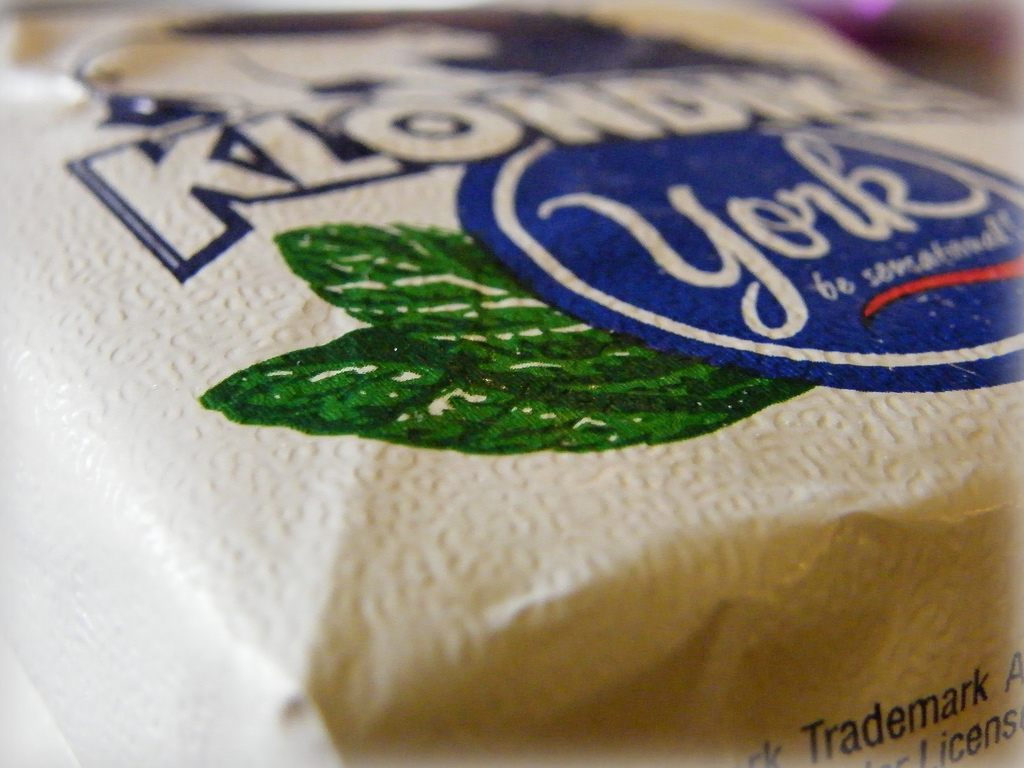The Twisted Things People Have Done For A Klondike Bar

An original Klondike Bar. (Photo: Keith Homan/shutterstock.com)
A version of this post originally appeared on the Tedium newsletter.
The iconic commercials from the 1980s suggested that people would perform extreme actions in the name of a chocolatey-coated ice cream rectangle, loaded up all big and thick, with no room for a stick. But what would people really do for a Klondike bar?
It turns out, more than you’d think. A rash of crimes in the ’90s up until today have been committed in their name. The novelty treat was the subject of a multi-million dollar trademark lawsuit whose effects still reverberate. Its success rocketed a small family dairy business to the global stage—before delivering crushing blows to the health of the family itself.
A typical Klondike response is like this one from Henry Clarke, whose company Clabir owned the brand’s parent company, Isaly, during the company’s early ’80s glory days.
“I never cease to stop thinking about Klondike, and every time I see one, even though it’s someone else’s product, if it’s not straight in the freezer case, I find myself straightening them,” Clarke told author Brian Butko for the 2000 book Klondikes, Chipped Ham, & Skyscraper Cones: The Story of Isaly’s. (Clark, a Warren Buffett-style investor with significant interests in the defense industry, died in 2013.)
But Clarke’s lingering interest in the bar was nothing compared to that of the Kraft company, which went to shocking lengths to make a Klondike bar of its own.
The chocolate bar was born in 1922, from a small regional dairy firm called Isaly. The family-owned business, launched by a family of Swiss immigrants, was originally based in Mansfield, Ohio but later affiliated with both Youngstown, Ohio and Pittsburgh, Pennsylvania. The firm was known for its dairy stores and restaurants, which sold sandwiches noted for their incredibly thin slices of processed ham, called “chipped chopped ham.” They also had another hit ice cream novelty called the “skyscraper cone,” which featured ice cream molded into a pointed shape, rather than in the traditional scoop style.
The Klondike bar came about as the family attempted to grow its regional dairy business, and was notable as one of the earliest attempts to market an ice cream product specifically for an adult market. But as it was only sold in the company’s own stores, its reach was limited. (One early marketing trick that the company used was that one in every 12 Klondike bars had a pink center. If you found one, your next Klondike bar was free. The trick, as you might guess, didn’t work so well after people started putting the bars in their own iceboxes.)

Oreo Klondike sandwiches. (Photo: Mike Mozart/flickr)
By 1978, Isaly was looking to start selling its ice cream bars outside of its traditional strongholds of Ohio and Pennsylvania, and struck a distribution partnership with Kraft Foods to bring the frozen treats down to Florida, and eventually, the rest of the country. It was a good deal for the two companies—Isaly got the reach it needed to turn its ice cream bar into a national hit, and Kraft got to reap some of the financial benefits.

Peppermint Klondike bar. (Photo: Melissa/flickr)
However, like any other huge corporation, Kraft wasn’t sated by just eating a tiny piece of a profitable business. Soon after the company started distributing the Klondike bar nationwide, they started to pressure Isaly’s to sell the ice cream bar to them. Isaly refused to play ball. So Kraft went into its food labs and began producing a close imitation of the product.
Through one of its acquisitions, Southern Dairy, Kraft had an out-of-use trademark, Polar B’ar, that proved a good fit for the new product. Outside of the name, the ice cream bar was effectively the same in all the ways that mattered: it was a square block of ice cream, covered in chocolate, and wrapped in foil paper.
In 1982, Kraft dropped its distribution deal with Isaly and started selling its own knock-offs in the eastern part of the United States. Isaly, which had soon changed its name to AmBRIT, soon filed a trademark suit. And that’s when things got really messy.
Kraft’s attempt to rip off the Klondike bar proved a major embarrassment for the company, and not only because of the trademark suit.
In 1986, the company voluntarily withdrew the Polar B’ar from the market as a result of a listeria outbreak. The contamination, which sickened dozens, first led the company to recall 25,000 cases of the ice cream—or roughly 1.8 million bars. When that failed to quell the problem, the company had shut down three factories and removed the product from the market entirely.
The timing of the product’s removal from the market was not ideal. The company was knee-deep in the midst of its trademark lawsuit with AmBRIT, and just five months later, the Eleventh Circuit Court of Appeals ruled against Kraft, with the court calling over the clear case of trademark infringement.
The case against Kraft was pretty strong, as John Minor Wisdom’s majority decision reveals:
Kraft employed two firms to design the packaging for the Polar B’ar product, making clear to these firms that the functional features of the Polar B’ar package were to resemble as closely as possible the Klondike bar package. The bars were to be wrapped in foil and sold in six-pack trays overwrapped in transparent plastic. Kraft supplied these design firms with samples of the Klondike packaging to aid them in their efforts.
This, AmBRIT successfully argued, created confusion in the market, with people mistaking Kraft’s offering for the real thing. And as the companies had a previous business relationship, it compelled the appeals court to find that “Kraft intended to benefit from the goodwill Isaly had built for itself.”
Complicating things even further, the appeals court decided that Kraft’s Polar B’ar trademark, which wasn’t in active use for nearly five decades, was no longer valid.
“Irrespective of whether a competitor has used the mark in question, a registered trademark, once abandoned, may be cancelled even after the holder resumes use of the mark,” Wisdom wrote.
However, one place where AmBRIT overplayed their hand was a claim that the royal blue color that the company used on its products deserved to be protected. The appeals court threw that one out quickly, because blue comes with the territory. “Royal blue is a ‘cool color’; it is suggestive of coldness and used by a multitude of ice cream and frozen dessert producers,” Wisdom wrote.
In the end though, the Klondike bar won out big. The next year, the case was petitioned to the Supreme Court, which rejected Kraft’s case without comment. Eventually, Kraft had to change its packaging, and paid AmBRIT $8.5 million for violating its trademark.
Isaly’s may have skipped out on a takeover attempt by Kraft and knocked out the larger opponent in court, but it couldn’t fight off Big Ice Cream for long. Unilever bought out the Klondike brand in 1993, making it a part of a growing ice cream empire, which includes Breyers, Good Humor, and Ben & Jerry’s. The bar itself is still at the top of the ice cream novelty heap, with 11.79 percent of U.S. households consuming the bars each year according to market research by Statista—a level that tops every other major brand of its kind, from Popsicle to Drumstick, and even tops the standard store brand.
The company’s famous jingle seems to have inserted itself in the American consciousness in surprising ways. In 2009, for example, a Florida man who really wanted a Klondike bar attempted to leave a store with a crushed Klondike bar in his back pocket, and after he was caught, he attempted to pay $69 for the bar—which the store generally sold for $1.29 each. Despite the willingness to fork over 60+ times the retail price, the man was still arrested.
The next year, a 23-year-old Idaho man was arrested in the basement of a local courthouse after robbing the facility of both its Klondike bars and its hot chocolate powder packets. This was a particularly bad idea, as the facility also includes the sheriff’s office, complete with jail cell. “The guy was really being stupid,” Sheriff Doug McFall said of the guy. And in 2012, a drunk Scranton man broke into a couple’s home and started making an elaborate surf-and-turf meal, then drank a bunch of their alcohol before making off with a box of Klondike bars.
There are other tales, too, involving this one involving a couple of 16-year-olds, and even incidents of violence involving arguments over Klondike bars that got out of hand.
It makes sense that there are T-shirts out there that say, “I’m ashamed of what I would do for a Klondike bar.”
But while Klondike lives, Isaly has faltered. In its heyday in the 1950s through the early 1960s, the company’s restaurant empire stretched from West Virginia to Iowa, at a time when America was full of countertop dairies and restaurants. As the book about the company’s history details, the trajectory of the industry helped bring about the suicide of Chester Isaly—who apparently felt pressured to keep his family’s business competitive in a dairy market that was increasingly becoming nationalized.
Today, the company has almost entirely faded from view. It still exists as a supermarket staple in the mid-Atlantic, a shell of its former self that’s been kept running by friends of the Isaly family. Restaurants that once used the Isaly’s branding have slowly started to drop it. It seems that the triumph of the Klondike bar is something of a pyrrhic victory for the Isaly family—it became a major success, but that success may have hastened an iconic regional dairy company’s fall into obscurity. And for fans of chipped chopped ham, that’s heartbreaking.
A version of this post originally appeared on Tedium, a twice-weekly newsletter that hunts for the end of the long tail.

Gastro Obscura covers the world’s most wondrous food and drink.
Sign up for our regular newsletter.















Follow us on Twitter to get the latest on the world's hidden wonders.
Like us on Facebook to get the latest on the world's hidden wonders.
Follow us on Twitter Like us on Facebook